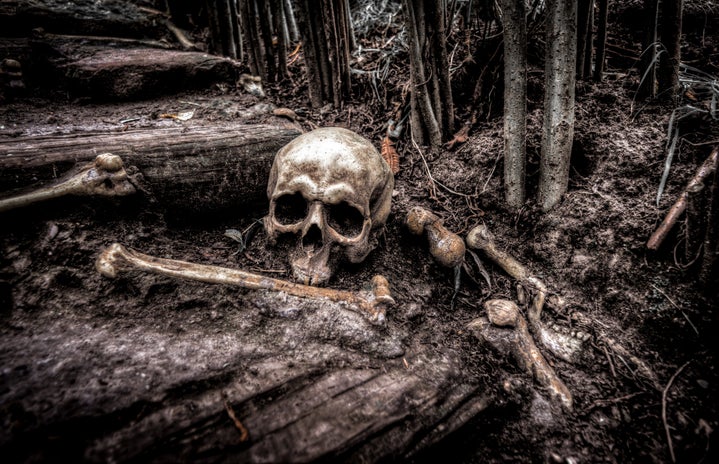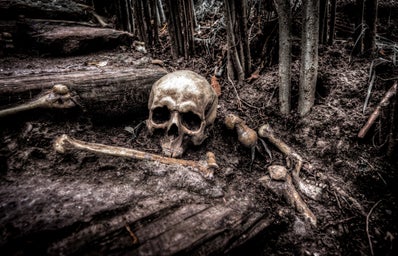On a cold day in 1942, a ranger by the name of Hari Kishan Madhwal is out on a hike in the Nanda Devi National Park when suddenly he comes across some human remains; many, many human remains. Since this happened during World War II, the lake wasn’t properly investigated for another 14 years.
(Retrieved from travelsetu)
Roopkund lake is a glacial lake located in the Indian region of the Himalayan mountains, roughly 16,000 feet in altitude, and the home of hundreds of human remains. The lake and its permanent skeletal residents have been the subject of much local speculation for hundreds of years, but it came into world wide speculation once the British came across it during their occupation of India in the early 20th century.
The Investigation
The lake started being properly investigated in 1956, 14 years after Madhwal’s discovery brought it into public consciousness. Here are a few things that were discovered:
Luxury items such as glass beads and birch parasols were found at the site. The victims seemed to have perished in a single event and their remains dated back to around 800 CE.
There wasn’t much else that could be recovered since unfortunately the human remains were scattered all over the place, making the identification of a single body quite difficult, and the elements had worn out a lot of the context of the site into nothing.
This left several questions in the air: What happened at Skeleton Lake all those years ago? Why were these people crossing the mountains? And what was powerful enough to wipe out over 200 people in a single event?
(Retrieved from thisday)
Theories
There are a lot of theories ranging from the ridiculous, such as Japanese soldiers getting caught unprepared while attempting an ambush (considering this was discovered right after World War II), ritualistic suicide, and even the idea of an ancient battleground; to more grounded theories such as the idea that it was a plague burial or a caravan.
Many of these theories have been disproven in one way or another. There was only one weapon found at the site, and only 6 skulls seemed to have some sort of blunt force trauma, disproving mass suicide and a battle. No animal remains were found, disproving the idea of the caravan as well. There is also no historical evidence of a plague in the nearby areas, and, according to later evidence, the remains, despite showing signs of anemia, seemed to be in otherwise good health.
The one theory that seems to be the most likely, however, is the theory of the Pilgrimage.
A pilgrimage gone wrong
For this theory, we need to turn to local legends. In the areas near Roopkund Lake, there’s a legend that goes back hundreds of years related to the goddess Nanda Devi. There’s several versions of this story, but the basic gist of it remains the same.
It is said that a king once took a pilgrimage to Nanda Devi’s temple with his wife. The king brought all sorts of dancers and jesters, jewelry and worldly pleasures. This opulent display angered the goddess. She sent iron balls from the sky in an icy storm, killing the king’s party.
Although this is a myth, we can gather a lot from it. It explains why beads and other luxury items were found at the site. The iron balls could’ve been a hailstorm, which would explain the blunt force trauma found in some of the skulls. It’s possible that a few survivors fled the scene, telling their stories and birthing the myth that we know today.
All of this makes it seem like the case is pretty much closed: a pilgrimage up the mountain goes horribly wrong around a thousand years ago. This would’ve been the case up until 2019, when something shocking was discovered.
Recent information
Recently, some studies were done on 38 of the most complete remains that could be found, and it led to some surprising discoveries. The evidence showed that, rather than being one single group, the remains consisted of three genetically distinct groups of people that were wiped out in two different events, with more or less a thousand years between each. These are referred to as groups A, B, and C.
Group A was identified to be of South Asian descent, of the same genetic groups as modern-day descendants from India, Pakistan, Bangladesh, etc. They seem to be the pilgrimage group, wiped out between 700 CE and 900 CE. This version of the story remains unchanged. Groups B and C, however, are different.
Group B seems to have originated from West Eurasia (most likely related to modern Greeks and Cretes). Group C, which consisted of only one individual, appears to have originated from East Asia (most likely related to modern-day Malaysians). Both groups show signs that they were traveling together and were wiped out in the same event, between 1700 and 1900 CE, 200 to 400 years ago.
Final Thoughts
Unfortunately, we do not know what happened to groups B and C or why they were even in the Himalayas in the first place. It is also very likely that we will never know, especially given the fact that the site had already deteriorated by the time investigations began. The lake is also covered by snow for most of the year, and now, due to tourism, the site gets a lot of traffic. A lot of the remains have been further displaced by visitors, taking away a lot of their original context and making it infinitely harder to investigate.
This said, it is still a fun mystery to research. There’s many things I didn’t cover in this article, from the folklore to other facts discovered about the remains. If you are still curious, I highly recommend further researching the topic and be sure to check out this video by miniminuteman which originally inspired this article.


